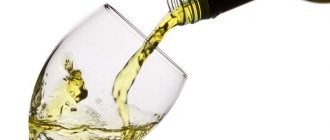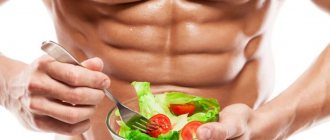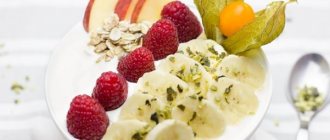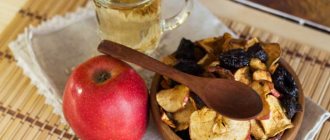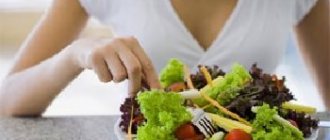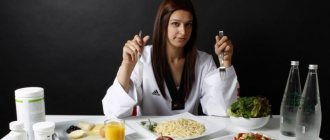Chemical composition and energy value of dietary table No. 5P (I)
Proteins: 85–90 g (including 45 g animal proteins). Fats: 70–80 g (including 1/3 of the amount - vegetable fats). Carbohydrates: 300–350 g. Daily calorie content: 2,100–2,500 kcal. Free liquid: 1.5–2 l. Table salt: 6–10 g Vitamins: retinol (A) – 0.3 mg, beta-carotene – 10 mg, riboflavin (B2) – 2 mg, thiamine (B1) – 1.3 mg, nicotinic acid (B3) – 6 mg, ascorbic acid (C) – 150 mg. Macroelements: sodium – 3 g, calcium – 0.8 g, magnesium – 0.5 g, phosphorus – 1.3 g. Microelements: iron – 30 mg. Optimal food temperature: from 20 to 50 degrees Celsius.
Diet features
Pancreatitis is a group of syndromes and diseases that are characterized by inflammation of the pancreas. Nutritional therapy for pancreatitis is not just part of a comprehensive treatment, it helps achieve remission and gets patients out of bed.
Table No. 5p according to Pevzner sets itself the following goals:
- Normalize the exocrine function of the pancreas;
- Reduce the phenomenon of stagnation in the ducts of the pancreas and duodenum;
- Reduce reflex excitability of the gallbladder;
- Ensure gentle bowel function;
- Prevent fatty infiltration and degeneration of liver and pancreas tissue.
Diet 5p for pancreatitis takes place 3-4 days after an exacerbation of the disease and a week after table 5a.
The energy value of the diet varies depending on the patient’s weight, physical activity and individual metabolic characteristics. The average daily caloric intake is 2500 calories.
Chemical balance of the daily menu:
- 200 grams of carbohydrates (30-40 grams of sugar);
- 80 grams of protein (60% animal origin);
- 40-60 grams of fat (15% vegetable).
Almost all products and dishes are bland. The amount of table salt is limited to 10 grams per day. On the contrary, the volume of free liquid consumed while observing the table should be increased to the maximum.
Meals should be frequent and small. Recommended 250 gram portions every 2.5-3 hours, resulting in 5-6 meals per day. Dishes are served warm; excessively cold or hot food should not be consumed.
Table 5p for pancreatitis according to Pevzner has no time restrictions. How long it is necessary to follow his menu - 1 week or 2-3 months - is determined by the attending physician. It is in his power to make a real prognosis for recovery, determine the time interval required to alleviate symptoms and prevent relapses of exacerbation of pancreatitis.
Recommended products and dishes of the dietary table No. 5P (I)
Bread: wheat crackers. Soups: slimy cereal soups with vegetable broth or water. Meat dishes: lean meats and skinless poultry in the form of boiled or steamed cutlets, soufflés, quenelles, etc. Fish dishes: boiled or steamed lean fish in the form of cutlets, soufflés. Side dishes: pureed vegetable purees, soufflé, pureed porridge and casseroles made from rice, oatmeal, buckwheat. Dairy products: steam soufflé from unleavened cottage cheese, non-acidic dairy products with caution if tolerated. Eggs: steamed egg white omelet. Snacks: excluded. Sauces: excluded. Sweet dishes: jellies, jelly, fruit mousses, baked apples; sugar – limited, it is recommended to use substitutes. Drinks: weak tea, pureed compotes, rosehip decoction. Fats: fresh unsalted butter in small quantities in dishes.
Authorized Products
Nutrition should be based on recommended products. They are not only healthy, but also have good taste. You can combine them and prepare a variety of dishes with them. We provide a table of the groups of foods allowed for regular consumption for pancreatitis (included in the first and second types of diet number 5 p).
| Products | Used | Kcal per 100 g. |
| Vegetables (prohibited to eat raw) | ||
| White cabbage | 1,7/0/5,3 | 27 |
| Brussels sprouts | 0/0/0 | 52 |
| red cabbage | 1,5/0/5,9 | 24 |
| cauliflower | 2,4/0/4,9 | 25 |
| eggplant | 0,3/-0,2/5,4 | 22 |
| broccoli | 2,8/0,5/4,9 | 26 |
| zucchini | 0,7/0/3,5 | 16 |
| boiled potatoes | 1,7/0,2/15,8 | 74 |
| mashed potatoes | 2,2/3,1/13,8 | 92 |
| carrot | 1,2/0/7,8 | 40 |
| cucumbers | 0,8/0/2,8 | 13 |
| Bell pepper | 1.1/0/5,7 | 17 |
| parsley | 3,4/0/8,2 | 38 |
| tomatoes | 0,8/3/3,8 | 23 |
| vegetable stew | 2.2/4,5/6,8 | 99 |
| radish | 1,2/0,2/3,1 | 19 |
| boiled beets | 1,8/0,2/11 | 52 |
| pumpkin | 1,2/0/4,2 | 21 |
| dill | 2,3/0,2/4,3 | 32 |
| leaf salad | 1,5/0/2,2 | 16 |
| pumped salad | 1,2/0/2 | 14 |
| Fruits (the first diet option involves only baked apples, the second - other fruits) | ||
| apricots | 1/0/10,1 | 47 |
| cherry plum | 0,3/0,6,5 | 28 |
| pineapples | 0,1/0/11,7 | 57 |
| bananas | 13/0/22,5 | 91 |
| grape | 0,1/0/17,3 | 70 |
| cherries | 0,9/0/11 | 52 |
| pears | 0,5/0/10,6 | 46 |
| melons | 0,5/0/9 | 37 |
| light varieties of raisins | 17/0/71 | 300 |
| dark raisins | 19/0/71 | 290 |
| nectarine | 0,9/0,2/11,9 | 45 |
| peaches | 1/0/10 | 44 |
| plums | 0,7/0/9,6 | 45 |
| persimmon | 0,2/0/12,8 | 55 |
| apples | 0,4/0/11,1 | 44 |
| Dairy | ||
| butter (no more than 30 g/day) | 0,2/84,4/0,2 | 780 |
| cow's milk | 3,3/3,5/4,6 | 65 |
| condensed milk | 7,8/8,8/55,6 | 346 |
| low-fat cream | 3/10/4,2 | 111 |
| sour cream | 2,6/29,6/2,7 | 300 |
| hard cheese | 26,6/30,1/0,2 | 380 |
| low-fat cottage cheese | 15,7/0,5/2,8 | 85 |
| Bakery products | ||
| bread made from premium flour | 10/2,2/53,8 | 284 |
| pancakes made from premium flour | 4,8/2,9/4,4 | 185 |
| waffles | 3/32,5/61,5 | 544 |
| premium pasta | 12,8/0,1/69,9 | 345 |
| wheat flour 1 grade | 10,7/4,2/72,8 | 350 |
| cracker cookies (eat softened) | 11/13,4/67,2 | 351 |
| sugar crackers (eat softened) | 9/4,8/72,7 | 376 |
| crackers (use softened) | 11,6/2,1/73,7 | 360 |
| white loaf | 7,4/7,5/67,8 | 371 |
| whole grain bread | 11.3/1,95/56,5 | 299 |
| dry biscuit | 8,48/4,85/58,36 | 311 |
| Cereals | ||
| porridge "Hercules" | 12,9/5,9/65,5 | 304 |
| buckwheat | 12.8/2,4/67,9 | 340 |
| semolina | 11,4/0,8/74 | 356 |
| semolina with cow's milk | 3,1/5,1/15,5 | 120 |
| cornflakes | 4,2/0,7/79,8 | 360 |
| oatmeal with milk (part 2 of the diet) | 4,5/5,1/13,5 | 114 |
| oatmeal on water | 1,4/1,3/9,2 | 48 |
| millet on water | 4,5/1,4/25,8 | 132 |
| Rice porridge with milk (2 type of diet) | 2,8/1,6/17,8 | 102 |
| rice porridge with water | 2,2/0,4/63,3 | 105 |
| boiled rice | 7,4/0,9/75,8 | 352 |
| barley | 10,6/11,4/71,5 | 345 |
| barley porridge with cow's milk (part 2 of the diet) | 3,8/2,2/19,8 | 107 |
| Vegetable oils | ||
| sunflower (up to 10 g/day) | 0/99,8/0 | 898 |
| olive (no more than 16 g/day) | 0/99,8/0 | 899 |
| Beverages | ||
| still water | 0/0/0 | 0 |
| green tea without sugar | 0/0/0 | 0,1 |
| carrot juice | 0,8/0,1/5,8 | 29 |
| grape juice | 0,3/0/13,8 | 54,5 |
| Pineapple juice | 0,2/0/13,3 | 52 |
| cocoa with cow's milk without sugar | 3,3/3,6/4,7 | 47 |
| unsweetened dried fruit compote | 0,7/0/14,3 | 62 |
| weak black tea without sugar | 0/0/0 | 0,5 |
| Meat and meat products | ||
| lean lean beef | 25,9/9/0 | 177 |
| chicken breasts | 29,7/16,9/0 | 138 |
| chicken fillet | 26/14/1 | 200 |
| rabbit | 20,9/13,8/0 | 180 |
| steamed beef dumplings | 15,6/11,1/8,2 | 195 |
| beef roll | 14,1/5,1/1,3 | 102 |
| chicken meatballs | 12,61/14,41/10,71 | 221,1 |
| Fish and seafood (lean and boneless) | ||
| flounder | 16,5/1,8/0 | 18 |
| blue whiting | 16,2/0,9/0 | 71 |
| pollock | 15,9/0,9/0 | 72 |
| cod | 17,8/0,8/0 | 79 |
| pike | 18,4/0,9/0 | 83 |
| hake | 16,7/2,2/0 | 85 |
| Soups | ||
| vegetable | 1,7/1,9/6,3 | 28,2 |
| creamy potato soup | 1,5/1,4/7,6 | 27,6 |
| potato | 1,5/1,2/6,5 | 38,1 |
| rice with milk | 2,7/2,2/9,1 | 65 |
| with vermicelli with milk | 2.8/2,4/8,5 | 65 |
| Eggs | ||
| half a yolk per day | 4,27/15,5/0 | 181 |
| steamed egg white omelette | 14,2/14,7/1.8 | 210 |
Products should be low-fat and non-acidic. It is recommended to puree vegetables. Fruits can be consumed finely chopped, grated, or in puree form. Carbonated drinks and water are prohibited. All juices must be diluted with water in a juice/water ratio of 60/40%. Low-fat varieties of meat and meat products are recommended.
Answers to frequently asked questions
Is it possible to eat dumplings?
You can eat dumplings in small quantities and no more than 1-2 times a month. The dish must be made from premium flour and minced lean lean beef or lean chicken. You can serve a little low-fat sour cream with the dumplings.
It is prohibited to use hot seasonings. It is contraindicated to eat dumplings with fatty sauces, mustard, and vinegar.
Includes table number 5 honey?
Due to the minimal sugar content in the product (1-4%), honey is an alternative to traditional sugar and sweetener substitutes. The high content of fructose and glucose in the product allows you to reduce the load on the secretory system of the pancreas and speed up its recovery.
Is monastery tea effective in treatment?
The exact composition of tea is unknown; each manufacturer makes amendments to the recipe. Scientific medicine is skeptical about such products. Their effectiveness is questionable. Therefore, it is impossible to recommend drinking monastery tea.
We invite you to watch a video from Dr. Evdokimenko, who will talk in more detail about nutrition for pancreatitis.
Excluded foods and dishes of the dietary table No. 5P (I)
From the diet you should exclude fried meat, fish, mushroom broths, saturated vegetable broths, cabbage, turnips, radishes, rutabaga, onions, garlic, leaf salads, sorrel, spinach, radishes, mushrooms, legumes, fatty meats, poultry and fish, liver, pickles, smoked meats, sausages, canned food, lard, animal fat, eggs (except for white omelettes), fresh bread, pastry, flour products, cream, full-fat milk, confectionery, chocolate, cocoa, seasonings, spices and sauces, ice cream, alcoholic drinks, carbonated drinks.
Prohibited Products
Both types of dietary table include prohibited foods. In the first version of the 5p table there are more of them, the second type is softer.
Prohibited foods for the first part of the diet:
The second part of the dietary table number 5p according to Pevzner is inferior to the first in terms of restrictions. The diet allows you to eat:
- bananas;
- low-fat milk soups;
- finely chopped fruits;
- boiled and/or steamed chopped vegetables.
| Products | Used | Kcal per 100 g. | ||
| Fatty meats | ||||
| pork | 16,2/27,8/0 | 398 | ||
| mutton | 16,3/15,1/0 | 305 | ||
| fatty beef | 19,2/12,6/0 | 202 | ||
| duck | 16,4/63/0 | 348 | ||
| goose | 29,4/22,3/0 | 320 | ||
| Meat products | ||||
| ham | 16,8/34,8/0 | 394 | ||
| beef brains | 11,7/8,8/0 | 123 | ||
| beef tongue | 23,8/15,2/0 | 234 | ||
| beef liver | 17,3/2,9/0 | 122 | ||
| boiled sausage | 11,7/28,1/2,8 | 300 | ||
| pork cutlets | 11,7/19,5/9,7 | 262 | ||
| sausages | 10,6/24/1,8 | 266 | ||
| lard | 1,3/89,9/0 | 840 | ||
| Caviar | ||||
| red | 31,4/13,9/0 | 260 | ||
| black | 26,9/16,3/0 | 258 | ||
| pollock | 28,1/2,1/0 | 133 | ||
| Cereals and crumbly porridges made from them | ||||
| pearl barley | 11/0,8/74,2 | 360 | ||
| millet | 11,8/2,8/69,5 | 330 | ||
| unpolished rice | 2,6/0,8/36,2 | 124 | ||
| Eggs (raw are strictly prohibited) | ||||
| boiled whole | 12,5/12/0,7 | 52 | ||
| fried | 12/14,4/1.1 | 58 | ||
| Bakery products | ||||
| baking | 7,6/4,7/54,8 | 260 | ||
| "Borodinsky" bread | 6,6/13,2/40,6 | 200 | ||
| Rye bread | 5,8/1,1/44,5 | 216 | ||
| rye/wheat bread | 6,6/0,9/42,2 | 215 | ||
| grain bread | 8,4/1,6/43,7 | 213 | ||
| Dairy | ||||
| kefir | 2,6/3,2/4,1 | 64 | ||
| mayonnaise | 3,2/66,9/2,8 | 699 | ||
| margarine | 0/82,3/,8 | 698 | ||
| curdled milk | 2,8/3,2/4,2 | 60 | ||
| fatty curdled milk | 3,5/3,9/3,9 | 66 | ||
| cream | 2,6/19,8/3,7 | 210 | ||
| fat sour cream | 2,6/25,3/3,2 | 249 | ||
| fat cottage cheese | 13,2/19,9/2,5 | 251 | ||
| Mushrooms | ||||
| white | 3,4/0,6/1,6 | 32 | ||
| salted mushrooms | 3,5/1,6/0,9 | 31 | ||
| boletus | 0/0/0 | 21 | ||
| boletus | 2,4/0,8/3,4 | 24 | ||
| boletus | 3,5/0,5/3,2 | 22 | ||
| Champignon | 0/0/0 | 24 | ||
| Sweets | ||||
| dark chocolate | 6,1/35,2/49 | 540 | ||
| milk chocolate | 4,8/3,5/52,5 | 550 | ||
| chocolate bars | 4,2/24,8/69,1 | 510 | ||
| halva | 12,5/29,9/50,7 | 526 | ||
| lollipops, caramel | 0/0,2/97,1 | 400 | ||
| marmalade | 0,4/0,2/75,8 | 307 | ||
| popcorn | 2,2/20,6/77,5 | 483 | ||
For any type of diet, it is prohibited to consume alcohol in any form, coffee and caffeine-containing products.
Sample diet menu No. 5P (I)
First breakfast: steamed protein omelet, pureed semi-liquid oatmeal with water, tea. Second breakfast: fruit jelly, tea. Lunch: slimy soup with rice and vegetable broth, chicken quenelles, berry soufflé. Afternoon snack: steamed cottage cheese soufflé, rosehip decoction. Dinner: fish soufflé, vegetable puree, compote. At night: crackers, rose hip decoction.
Sources:
- Order of the Ministry of Health of the Russian Federation No. 330 “On measures to improve clinical nutrition in medical institutions of the Russian Federation” dated 05.08.2003
Menu for children
For a child, nutrition is selected together with a pediatrician, gastroenterologist, and nutritionist. The protein content in products should exceed that in the menu for adults, since the patient continues to grow, and proteins are the main “building” material for the body.
Photo: www.sarahremmer.com
Here is an example of a menu for every day (it can be adjusted in accordance with children's taste preferences):
Monday:
- breakfast – buckwheat soup, sweet crackers, milk cocoa;
- 2 breakfast – baked apple with cottage cheese;
- lunch – soup with lean chicken, vegetable pudding;
- afternoon snack – sweet cracker, diluted juice;
- dinner – steamed chicken fillet, steamed vegetables with potatoes, low-fat milk;
Tuesday:
- 1 meal – milk rice porridge, protein omelet, low-fat milk;
- lunch – dry biscuit, honey, cocoa;
- lunch – beef dumplings, cream cheese soup, tea;
- afternoon snack – baked apples;
- dinner – vegetable stew or puree, steamed chicken fillet, sweet cracker, milk;
Wednesday:
- breakfast - pudding with fruit, milk rice soup, milk;
- Meal 2 – fruit puree;
- lunch – soup with lean chicken, vegetable salad, steamed chicken dumplings;
- Meal 4 – fruit puree;
- Meal 5 – baked cod, vegetable stew or puree;
Thursday:
- breakfast – cottage cheese casserole with apples, cocoa with milk;
- Meal 2 – banana mousse, low-fat milk;
- lunch – chicken meatballs, buckwheat soup, dry biscuit, compote;
- Meal 4 – milk, cottage cheese pie;
- dinner - mashed potatoes, baked or steamed hake, diluted juice;
Friday:
- 1 meal – protein omelet, baked vegetables, low-fat milk;
- lunch – dry biscuit with honey, juice;
- lunch – vegetable soup, baked hake, weak black tea;
- afternoon snack - fruit pie;
- dinner - protein omelet, boiled porridge, low-fat milk;
Saturday:
- breakfast - milk soup, fruit pie, weak black tea;
- Meal 2 – cottage cheese casserole with fruit; quick recipes for cottage cheese dishes
- Meal 3 – cream cheese soup, boiled chicken fillet, low-fat milk;
- afternoon snack - vegetable pie;
- Meal 5 – chicken meatballs, vegetable stew, juice;
Sunday:
- breakfast – milk soup with noodles, cottage cheese casserole, cocoa;
- lunch – dry biscuit or low-fat cottage cheese;
- lunch - baked cod, vegetable or rice soup, boiled porridge, diluted juice;
- Meal 4 – cottage cheese pie, baked apples with cottage cheese;
- dinner - vegetable stew, boiled chicken breast, noodle casserole (recipes for delicious cottage cheese casserole), diluted juice.
Diet No. 5p according to Pevzner
The original table 5 is not only suitable for those who suffer from pancreatitis. The diet is intended for patients with cholecystitis, chronic or acute hepatitis during the recovery period, cirrhosis (beyond the stage of liver failure and in the absence of other gastrointestinal pathologies).
The essence of the method is to enrich the diet with lipotropic substances, for example, lecithin, choline and methionine. The amount of liquid and fiber in the diet is added, and refractory fats, cholesterol-containing, nitrogenous extractive substances are excluded if possible. This helps to normalize the functioning of the biliary tract and liver, the accumulation of glycogen in it, and stimulates bile secretion and intestinal motility.
